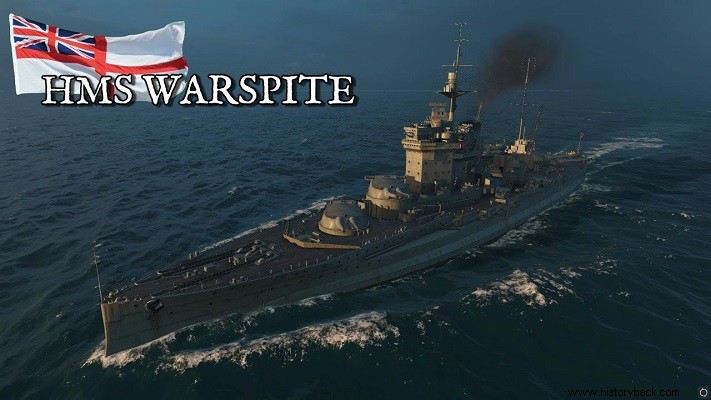
HMS Warspite has been the legendary warship of the modern British Navy. He performed exceptionally well in both world wars. He served for 30 years, but unfortunately the old warrior, although he survived enemy missiles and torpedoes, did not have the luck he deserved.
The vessel was 196.2 m long, 27.6 m wide and 10.1 m draft. Its full displacement was 33,794 tons. Propelled by Brown-Curtis steam turbines. It had 27 Yarrow boilers. It had a range of 9,260 km at a speed of 12 knots. It had a crew of 1,025 men. After its reconstruction the crew increased to 1,300 men.
Warspite, the "grand old lady" as her crew called her, was one of the "fast battleships" of the Queen Elizabeth class. These boats carried 15in (381mm) Mk I guns, which fired a projectile weighing 879kg. The boats were nicknamed "fast" as they developed a maximum speed of 24 knots compared to 19-22 for most other battleships of the time.
In addition to the eight main guns mounted in four twin turrets, the ship originally had 14 6in (152mm) guns. Later six of these were removed. Also, at the time of her construction, she had two 76mm anti-aircraft guns and four 21in torpedo tubes.
In 1936-37 the vessel was dramatically rebuilt. She received new engines, four twin 104mm heavy anti-aircraft guns, four quadruple 40mm pom-pom anti-aircraft guns and four quadruple 12.7mm machine guns. Also increased the elevation of the main guns to achieve a range of 26,500m A catapult was also installed that could serve four seaplanes.
The shape of the vessel changed drastically with the acquisition of a new "tower" bridge and reinforcement of the armor. The battleship belt had a maximum thickness of 13in (330mm). The deck armor originally had a maximum thickness of 76mm and after reconstruction 127mm. Speed reduced by one knot.
World War I and Interwar
Warspite entered service in 1915. Attached to the 5th Battleship Squadron of the Grand Fleet she was at Jutland on 31 May 1916. The squadron, under Admiral Beatty, was initially engaged with Admiral Hipper's German battlecruisers. The Warspite with one of its first shots seriously hit the German Von Der Tann. Soon, however, the German battleships also intervened and the situation became very difficult for the British. Warspite hit and with a damaged rudder circled helplessly as German fire made the sea "boil".
Everyone then believed that the ship was hopeless. Warspite was hit 13 times. Nevertheless he survived and thanks to the efforts of his crew the rudder was repaired and the ship escaped. However, it was in dire straits. Only one turret of the main guns could still fire.
The lucky boat was miraculously saved. In fact, during his return voyage, he was attacked by a German submarine. Three torpedoes were fired at it, but none hit it . When he returned to base, 150 enemy shell holes were counted on him. However, the loss of life was small as 14 crew members were killed and 16 wounded. The repairs took two months.
Shortly after the repairs were completed the vessel collided with the battleship Valiant during a night exercise. It was the second collision. In 1915 she had collided with Bharam, while in the same year she had fallen on a reef. Following the new conflict their commander Captain Philpott was removed.
But again misfortune followed as she collided with a destroyer and also crashed into the wharf at the base of Scapa Flow as a result of the blowing up of the battleship St. Vincent. The vessel participated in operations in 1918 but was again withdrawn due to a fire in the boiler room.
In 1924 the vessel underwent a small-scale modernization and assumed duties as flagship of the British Mediterranean fleet in 1926. The following year she ran aground on an uncharted reef in the Aegean and required repairs.
In 1930 she joined the Atlantic fleet. During the stop of the crews of the British fleet in 1931 three of its sailors were arrested. In 1933 she was rammed by a Romanian vessel off Portugal due to heavy fog, but held on. It then underwent extensive modernization.
World War II
Warspite's first mission after the outbreak of the new war was convoy escort. The vessel was ordered to pursue the much faster German battleships Scharnhorst and Gneisenau which she was unable to catch.
In April 1940 the ship was sent to Norway. Escorted by nine destroyers she fought at Narvik, sinking German destroyers while her aircraft sank a submarine. The battleship returned unscathed to its base and was then sent to the Mediterranean.
In the first conflict with the Italians, in the naval battle of Calabria, on July 9, 1940, it hit the Italian battleship Giulio Cesare from a distance of 26,000 m, putting the opposing fleet to flight. The Italians attacked the British ships with 120 aircraft but achieved nothing.
After three Italian battleships were torpedoed at Taranto by British aircraft, Warspite and Valiant bombarded Avlona in Albania. The ship was hit by an Italian bomb but the armor held.
This was followed in March 1941 by the naval battle of Cape Matapa which ended in a proud British victory, with Warspite participating in the sinking of two Italian heavy cruisers and two destroyers. Another Italian heavy cruiser was lost in the naval battle.
In the battle of Crete the boat was seriously damaged by German aircraft and had 38 dead. The heavily damaged battleship was sent to the US for repairs.
After repairs she sailed to the Indian Ocean and took part in the operations there. She then sailed to South Africa and after repairs returned to Britain in May 1943. She then again sailed to the Mediterranean and took part in supporting the Allied landings in Sicily and then Calabria and Salerno. There he was seriously hit by German aircraft, losing nine men.
After being repaired as much as possible – one main tower remained permanently out of commission – it took part in supporting the Allied landings in Normandy . During the operations there, he ran into a mine. After repairs she continued to support Allied operations off the French and Belgian coasts.
Warrior to the end
After the war there was intense debate about whether the historic vessel should be turned into a museum or scrapped. Unfortunately, in 1946, it was decided to dissolve it. On the way to the scrapyard, however, the boat ran aground in Cornwall as if it did not want such an end. The vessel remained at the scene despite attempts to tow it. In 1955 she finally broke up where she ran aground.
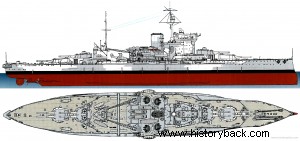
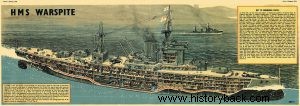
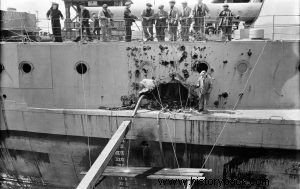
Warspite with the wounds of Jutland.
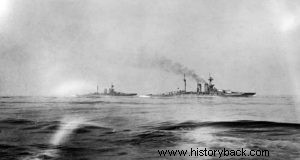
The battleships Warspite and Malaya at the Battle of Jutland in 1916.
